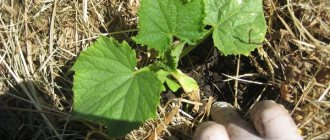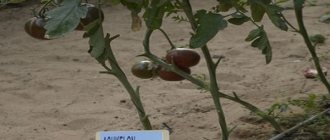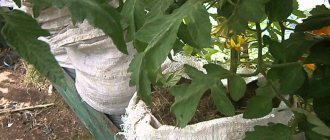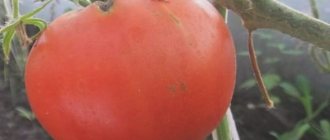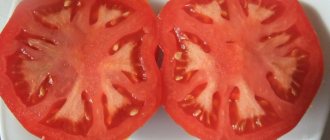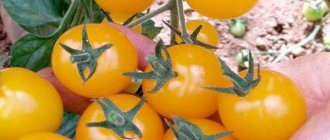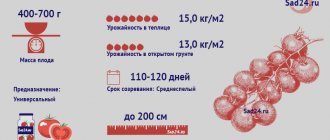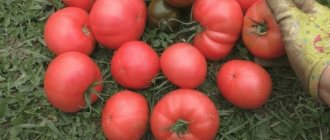Methods of growing tomatoes
There are 3 ways to effectively grow tomatoes:
- In the ground. The tomato is a capricious vegetable; it loves light and warmth, and does not tolerate wind and excess moisture. It is not difficult to get a good harvest in open ground, observing simple conditions. There are three rules for getting excellent tomatoes: you need to choose a variety suitable for the area, choose a sunny place, and ensure regular watering.
Tomatoes are unpretentious to soil
- In the greenhouse. The technology of growing in a greenhouse has its own characteristics. A warm and humid climate is favorable conditions not only for the development of tomatoes, but also for the proliferation of pests and pathogenic microflora. Prevention of problems of this kind will include crop rotation (alternating the cultivation of different crops in one place), control of humidity and periodic ventilation.
You can grow a tomato tree in a greenhouse
- Upside down. The seedlings are placed in a pot or inverted bucket and covered with soil, then hung and watered. In this case, there is no need to loosen, weed the soil, or use pesticides. This method makes it possible to plant tomatoes where there is little space or the soil is infertile.
An original way to grow tomatoes
What varieties of tomatoes can be grown without seedlings in the middle zone?
Tomato varieties should not only be very early, but also cold-resistant, resistant to diseases and temperature changes. It’s good if the packaging with seeds says: “Suitable for growing without seedlings.” But there are few such varieties, among them: “Amur Standard” , “Bezrassadny (Sprint-2)” , “Spring Frosts” , “Explosion” , “Far North” , “Subarctic” , “Yamal” .
In addition to these varieties, you should pay attention to the following varieties. They belong to the early and super early varieties, are unpretentious in cultivation, and are resistant to weather changes:
- "Iceberg" - early, cold-resistant, resistant to temperature changes.
- “Juggler” from breeder L. A. Myazina is drought-resistant, heat-resistant, and resistant to low temperatures.
- "Leopold" is ultra-early ripening, cold-resistant, undemanding to care, resistant to major tomato diseases.
- “Duckling” is early, disease resistant. It is distinguished by good fruit set even in unfavorable conditions and uniform fruiting.
- “Lollipop” tomato is incredibly unpretentious and productive; it belongs to very early varieties.
- “Leningrad Chill” is super early and has exceptional cold resistance.
- “Severyanin” is an ultra-early plant that sets fruit well at low temperatures.
You can also sow tomato varieties “Boni MM” , “Flash” , Gnome , “Sanka , “Bullfinch” , “Snowdrop” , “Shuttle” , “Apples on the Snow” .
When the tomato seedlings have 2-3 true leaves, you will need to leave the strongest sprout and remove the rest.
How to choose a tomato variety
Currently, there are a huge number of tomato varieties.
According to the method of planting, they are divided into: street, greenhouse, balcony and indoor. There are giant and miniature varieties; red, orange, black or yellow. Which variety is better? Each gardener has his own. In order not to make a mistake with your choice, decide where you plan to plant the variety (small-fruited varieties have a chance to ripen in open ground, large tomatoes can be grown in a greenhouse), take into account climatic features (each region has its own varieties of tomatoes) and plans for use harvest (for harvesting it is better to grow medium-fruited plants). Experienced gardeners constantly experiment with varieties, try new ones and be sure to record the results.
Tomatoes can be more than just red
According to the speed of ripening, all varieties of tomatoes are divided into:
— early ripening (ripen at the end of July);
— mid-ripening (ripen at the end of August, at the beginning of September);
- late varieties (ripen at the end of September).
Tomato seedlings at home. Growing and picking tomatoes
In order to provide themselves with tomatoes for the whole summer, gardeners plant bushes with different ripening rates.
Tomatoes in a planter from Lana Tarba
Photo by Lana Tarba
Photo by Lana Tarba
Photo by Lana Tarba
Photo by Lana Tarba
Photo by Lana Tarba
Photo by Lana Tarba
I want to talk about my experience growing vegetables and herbs in the so-called “trough” planter. So, it all started in 2013, when a colleague visited the Chelsea anniversary exhibition and brought back a bunch of photographs. I carefully reviewed these photos and paid attention to the planter model (at that time I didn’t know this word and had no idea what to “call it”). That same season, they made my first sample (my drawing), and I began testing growing vegetables in a “trough.”
Briefly about agricultural technology: I fill the planter two-thirds with grass (in the spring I rake old and fresh, spill with water, compact), one-third is garden soil with compost. After shrinking, the grass occupies about half the volume. She holds water; decomposing, provides warmth and nutrients.
Be sure to place a thick film on the bottom of the planter, and a sewn cover made of black dense spunbond on the film. The “trough” itself is made of larch boards, rather carelessly treated with an antiseptic (I was in a hurry!).
In the first year, I grew mainly salad greens and spices. In the following seasons, I experimented with a different set of vegetable crops. Carrots and all sorts of salads turned out very well. I always plant spices in technical pots so they don’t grow, and in the fall I bring them home. In winter, these pots sit on the loggia until we eat all the greens. In addition, I would like to say that the “trough” device is simply ideal for the root system; the main thing is to prevent the soil from drying out. You can see the result yourself. Last summer was hot.
For the winter, I throw all the soil into the beds, turn the “trough” over onto boards, and put a cover on top.
How to grow tomato seedlings
Seeds are sown in low boxes about 10 cm high.
The poured soil must be allowed to settle for 2 days, otherwise the seeds will end up at a shallower depth than they were planted. Furrows 2-3 cm deep are considered optimal for sowing tomatoes. The distance between furrows is 3-4 cm. Seeds are sown at a distance of 0.5 cm from each other. You can water before and after sowing seeds. Tomatoes Sowing seeds for seedlings
Ideal seedlings, ready for planting in the ground or greenhouse, should be 40 cm high, have the first cluster of flowers and a developed root system.
Seedling care
If comfortable conditions are maintained, the seeds will germinate amicably, after which they need to be provided with competent care.
Watering
Seedlings are more sensitive to underwatering or excess water than adult seedlings. When watering, you must follow the following rules:
- after planting the seeds, the first watering is carried out on the 2nd or 3rd day after the appearance of more seedlings;
- water the seedlings strictly at the root or pour water between the rows;
- Watering is carried out only with warm water (23°C).
When watering tomato seedlings, try not to get it on the leaves and stems of the plant.
After mass germination, seedlings are watered frequently - once every 3 - 4 days, adjusting the frequency in accordance with the air temperature and the speed of soil drying. After picking, watering is carried out for 3–4 days. The frequency of watering pickled seedlings is once every 7 – 10 days.
Top dressing
The first feeding of seedlings is carried out when the first true leaf appears on the seedlings. To saturate the tomato with the necessary microelements, you can use complex fertilizers - Effecton, Agricola, Atlet or Nitrophoska. You can also use wood ash or yeast to feed seedlings. The second feeding is carried out 1.5 weeks after picking.
In addition to root feeding, foliar feeding can also be done. In case of a lack of microelements, and as a result - poor growth of seedlings, this method will help to quickly saturate the plants with the missing substances. You can spray with the same fertilizers that are applied by the root method, but the solution is prepared less saturated. A few hours after spraying, it is recommended to spray the seedlings with clean water from a spray bottle.
Foliar feeding will allow you to very quickly replenish the lack of microelements
Picking
For tomato seedlings, this procedure is very important. It helps the seedling to grow a sufficient root system, which allows it to receive more nutrients and moisture.
Usually the procedure is carried out 10–14 days after germination. By this time, the seedling should already have at least 2 true leaves.
Tomatoes are one of the few plants that easily tolerate the picking process.
Timing for transplanting tomato seedlings into the ground
Before transplanting into the ground, seedlings need to be hardened off. To do this, take the plants out onto the balcony or street for 1.5 weeks.
If you live in a cold region, start hardening by increasing the ventilation time, but do not leave the plants in a draft. Then the seedlings can be taken out onto a closed balcony.
The timing of planting seedlings in the ground depends on the climatic conditions of the region. In the southern regions, this event is held early - from the end of April and throughout the first half of May. At this time, the sun has already heated the soil to the required 15°C. But at night the temperature can sometimes drop sharply, so it would be nice to have a light shelter in the garden bed that will protect the rooting seedlings from cold weather at night.
In cool regions, for example, in the Urals or Siberia, planting is carried out much later, starting from the end of May and even taking place at the beginning of June. Daytime temperatures in these areas, as well as in central Russia, are far from comfortable, so seedlings are often immediately planted under film cover.
Transplant only hardened seedlings and in due time
Place for planting tomatoes
The ideal place for growing tomatoes in open ground is considered to be areas protected from the wind, sufficiently illuminated, and warmed up.
Tomatoes are less demanding on soil fertility than other vegetables. Therefore, almost any soil with a neutral or slightly acidic environment is suitable for successful cultivation. Preference is given to light and highly fertile soils of sandy loam and loamy type. Compost or humus is added to low-fertility soils in the fall. When applying organic fertilizers annually, it is permissible to grow a tomato for 2-3 years in one place (last year’s tomatoes were not sick).
Tomato abundance. From seed to harvest
Good predecessors of tomatoes are: pumpkin, legumes, cabbage, onions and root vegetables. After growing nightshade crops (eggplants, peppers, potatoes), the plot is allocated for tomatoes after 3 years.
Planting tomatoes
To plant seedlings, you need to prepare and water them.
The depth of the hole is similar to the height of the seedling glass. Strong seedlings are planted in the soil at right angles. Seedlings of tall varieties and elongated ones - at an angle of 45°. Next, the holes with plants need to be filled with soil, compacted a little and watered. You need to install a peg next to the stem of the plant, which will serve as a support. When planting, an interval of about 60-70 cm is maintained between the rows, and 30-40 cm between plants. The planting density of tomatoes is:
- for indeterminate (tall varieties) or hybrids - plant 3-4 plants per square meter;
- for determinate varieties (with limited growth of the main stem), when grown in 1 stem - 6-10 plants per square meter, and when grown in 2-3 stems - from 3 to 6 plants.
Planting tomatoes, how to plant tomatoes
Disease and pest control
Damage to tomatoes by diseases and pests leads to a decrease in yield and negatively affects the quality of the fruit:
- their sizes decrease;
- taste and appearance deteriorate.
The causes of problems may be:
- violation of crop rotation rules;
- insufficient ventilation of the area.
will help prevent the appearance of pests and protect tomatoes from diseases : disinfecting the soil in the fall, timely application of fertilizers in the required doses and preventive treatment of seedlings with fungicidal preparations.
Protection against diseases
Tomatoes can suffer from both fungal and viral diseases.
Fungal diseases
- With late blight , rusty-brown spots appear on the leaves, stems and fruits.
- Powdery mildew manifests itself as a white coating on both sides of the leaf.
- Blackleg causes the stem to dry out at the root.
- Gray rot covers the above-ground parts of the plant with a grayish coating and leads to drying and falling of the fruit.
- Black spots near the stalk and rusty spots on the lower leaves are a sign of dry spot (Alternaria blight).
- With blossom end rot , the rotting of tomatoes begins with the appearance of a wet spot that turns black over time.
- The formation of light areas on the leaves, which become brown over time, and the appearance of olive-colored patches with a brownish coating on the fruits are evidence of cladosporiosis (brown spot) disease.
Fungicides are used to combat fungus:
- "Revus";
- "Acrobat";
- "Quadris";
- "Tattoo".
Viral infections
- Mosaic , when mosaic spots appear on swollen leaves, and areas with patches of yellowish color appear on the fruits.
- Stolbur , in which the foliage turns yellow and dries, and the tomatoes themselves harden.
- Aspermia , when the top of the plant begins to bush, the leaves curl inward and become smaller, the fruits also become smaller and harden.
Important! Diseases caused by viruses cannot be cured, and the affected bushes must be removed.
Protecting tomatoes from pests
- Root nematode: Small round worms damage the main root of the plant. To combat, disinfection of soil and equipment is used.
- Wireworm larvae infect the root system and eat up the stem. They get rid of pests by introducing poisonous baits into the soil.
- Spraying with insecticidal preparations once every 2 weeks helps against aphids, whiteflies and potato flea beetles
- Mole cricket , which destroys seedlings by gnawing roots and stems, is destroyed using poisoned baits, which are buried 10 cm into the ground.
- To get rid of cutworm butterfly caterpillars , which feed on fruits by gnawing into them, the bushes are treated with insecticides 14 days after planting the seedlings.
Watering and fertilizing tomatoes
The most favorable combination for tomatoes is the soil moisture under the bush is about 85-90%, and air humidity is 50%.
It is better to water tomatoes at the root early in the morning with warm water. It is better to mulch the soil. The correct watering regime must be observed: after planting, the seedlings are watered and left for three days. Then water it 1-2 times a week quite generously, but taking into account the variety, size and weather conditions.
Tomatoes are watered with warm water
Types of fertilizers optimal for tomatoes:
— Phosphorus-potassium fertilizers will help produce tomatoes with a low nitrate content.
— Potash fertilizers (potassium sulfate or ash are suitable).
— Microfertilizers containing boron and magnesium are the most optimal for tomatoes.
— Organic fertilizers will contribute to productivity. Use compost, humus, fermented green grass, mullein infusion or bird droppings.
Methods for ripening tomatoes
To ripen green fruits, we select medium and large healthy fruits.
We put them in 2-3 layers in a container and cover them with dry sawdust or paper. The optimal ripening temperature is about 12-15 C, and the humidity is 80%. After placing them in containers, we close the tomatoes at the top, as they like to ripen in the dark. The process lasts 30-40 days. As a rule, large tomatoes ripen first.
Tomatoes ripen well in a box
How to preserve your tomato harvest?
Tomato fruits are harvested in different degrees of ripeness: red, milky, pink brown and green.
It depends on where they plan to be used. For eating and making paste or tomato juice, red tomatoes are better suited. In order to pickle or pickle tomatoes, it is better to choose brown ones, and for storage and ripening they use milk or green ones. How to preserve stuffed tomatoes
The editors of uznayvse.ru remind you that the shelf life directly depends on the degree of ripeness of the tomatoes: red tomatoes are stored for no more than 4 days, pink ones - up to 5, milk tomatoes - up to 7, and green ones - about 10 days. Brown and pink fruits withstand long transportation better.
